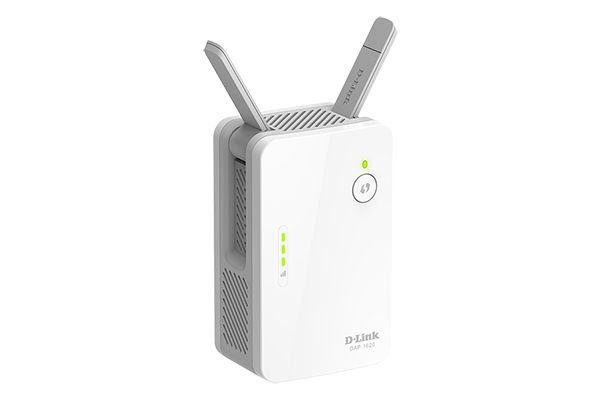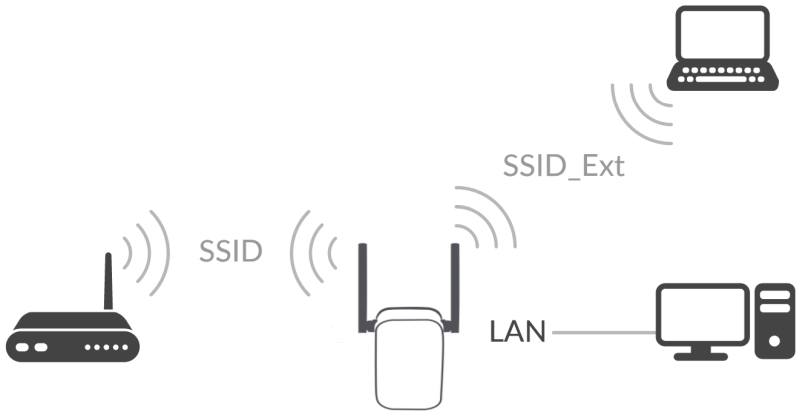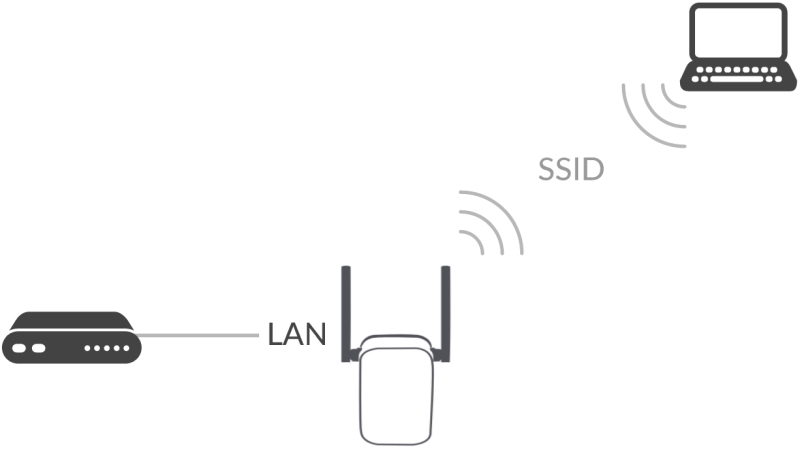
DAP-1620
AC1300 MU-MIMO Wi-Fi Range Extender
Description
Wireless Interface
The wireless extender DAP-1620 is a portable device designed to increase the operational range of your wireless network. The extender supports operation with wireless devices of the standards 802.11a, 802.11b, 802.11g, 802.11n, and 802.11ac. DAP-1620 delivers reliable, high-speed wireless performance up to 867Mbps for 5GHz using the 802.11ac standard and up to 400Mbps for 2.4GHz. Simultaneous activity of 2.4GHz band and 5GHz band allows performing a wide range of tasks.
Secure Wireless Connection
The device supports multiple functions for the wireless interface: several security standards (WEP, WPA/WPA2), MAC address filtering, different operation modes (repeater, client, access point), WPS, WMM.
Advanced Capabilities of Wireless Network
The Super MESH1 function allows to quickly connect multiple D-Link devices supporting Super MESH into one transport network, for example, when it's required to provide high-quality Wi-Fi coverage without dead zones in living units of complicated planning or it's needed to create a large temporary Wi-Fi network for an outdoor event.
Multi-user MIMO technology allows to distribute the extender's resources to let multiple wireless clients use the Wi-Fi network efficiently, keeping high rates for HD media streaming, lag-free gaming, and fast transfer of large files.
Transmit Beamforming technology allows to flexibly change the antennas' radiation pattern and to redistribute the signal directly to wireless devices connected to the extender.
Smart adjustment of Wi-Fi clients is useful for networks based on several D-Link access points or routers – when the smart adjustment function is configured on each of them, a client always connects to the access point (router, extender) with the highest signal level.
LAN Port
The wireless extender is equipped with one Gigabit Ethernet LAN port, which can be used to connect a wired client to the extender or to connect DAP-1620 to a wired router.
Signal Strength LED
The LED clearly shows the signal level of the wireless network to which DAP-1620 is connected. Due to this, you can easily find the best location for the extender.
Security
The SSH protocol support provides more secure remote configuration and management of the extender due to encryption of all transmitted traffic, including passwords.
Now the schedules are also implemented; they can be applied to MAC filter rules and used to reboot the extender at the specified time or every specified time period and to enable/disable the wireless network.
Easy Configuration and Update
You can configure the settings of the DAP-1620 device via the user-friendly web-based interface (the interface is available in several languages).
The configuration wizard allows you to quickly switch the extender to the access point, repeater, or client mode and configure all needed settings for the selected mode in several simple steps.
You can simply update the firmware: when the Internet access is provided, the extender itself finds approved firmware on D-Link update server and notifies when ready to install it.
Repeater Mode
You can connect DAP-1620 in the repeater mode to a wireless router for extending the range of the existing wireless network.

Client Mode
In the client mode, you can let a wired PC connected to DAP-1620 access the network of a wireless router.

Access Point Mode
You can connect DAP-1620 in the access point mode to a wired router for adding a wireless network to the existing local network.

1Super MESH is not compatible with EasyMESH. Super MESH can be unavailable in some FW versions (for the latest data, please refer to the page of the relevant device).
General features
|
Hardware
|
|
|
Processor
|
• MT7621AT (880MHz, dual core)
|
|
RAM
|
• 128MB, DDR3 SDRAM
|
|
Flash
|
• 16MB, SPI
|
|
Interfaces
|
• 10/100/1000BASE-T LAN port
|
|
LEDs
|
• POWER/WPS
• Wi-Fi Signal Strength
|
|
Buttons
|
• WPS button to set up wireless connection
• RESET button to restore factory default settings
|
|
Antenna
|
• Two external non-detachable antennas (1dBi gain for 2.4GHz and 2dBi gain for 5GHz)
|
|
MIMO
|
• 2 x 2, MU-MIMO
|
|
Power connector
|
• CEE 7/16 plug for AC power supply
|
|
Software
|
|
|
Network functions
|
• DHCP server
• Advanced configuration of built-in DHCP server
• Stateful/Stateless mode for IPv6 address assignment
• Automatic obtainment of LAN IP address
• DNS relay
• Autonegotiation of speed, duplex mode, and flow control/Manual speed and duplex mode setup for Ethernet port
|
|
Firewall functions
|
• MAC filter
|
|
Management and monitoring
|
• Access to settings through SSH/TELNET/WEB (HTTP/HTTPS)
• Multilingual web-based interface for configuration and management
• Firmware update via web-based interface
• Automatic notification on new firmware version
• Saving/restoring configuration to/from file
• Support of logging to remote host
• Automatic synchronization of system time with NTP server and manual time/date setup
• Ping utility
• Traceroute utility
• Schedules for MAC filters rules, automatic reboot, and enabling/disabling wireless network
|
|
Wireless Module Parameters
|
|
|
Standards
|
• IEEE 802.11a/n/ac
• IEEE 802.11b/g/n
|
|
Frequency range
The frequency range depends upon the radio frequency regulations applied in your country
|
• 2400 ~ 2483.5MHz
• 5150 ~ 5350MHz
• 5650 ~ 5850MHz
|
|
Wireless connection security
|
• WEP
• WPA/WPA2 (Personal/Enterprise)
• МАС filter
• WPS (PBC/PIN)
|
|
Advanced functions
|
• Super Mesh function
• Support of client mode
• WMM (Wi-Fi QoS)
• Information on connected Wi-Fi clients
• Advanced settings
• Smart adjustment of Wi-Fi clients
• Support of MBSSID
• Limitation of wireless network rate
• Periodic scan of channels, automatic switch to least loaded channel
• Support of 802.11ac (5GHz) and 802.11n (2.4GHz) TX Beamforming
• Autonegotiation of channel bandwidth in accordance with environment conditions (20/40 Coexistence)
|
|
Wireless connection rate1
|
• IEEE 802.11a: 6, 9, 12, 18, 24, 36, 48, and 54Mbps
• IEEE 802.11b: 1, 2, 5.5, and 11Mbps
• IEEE 802.11g: 6, 9, 12, 18, 24, 36, 48, and 54Mbps
• IEEE 802.11n (2.4GHz): 6.5–300Mbps (MCS0–MCS15) to 400Mbps (QAM256)
• IEEE 802.11n (5GHz): from 6.5 to 300Mbps (from MCS0 to MCS15)
• IEEE 802.11ac (5GHz): from 6.5 to 867Mbps (from MCS0 to MCS9)
|
|
Transmitter output power
The maximum value of the transmitter output power depends upon the radio frequency regulations applied in your country
|
• 802.11a (typical at room temperature 25 °C)
12dBm (±2 dB)
• 802.11b (typical at room temperature 25 °C)
14dBm (±2 dB)
• 802.11g (typical at room temperature 25 °C)
15dBm (±2 dB)
• 802.11n (typical at room temperature 25 °C)
2.4GHz
15dBm (±2 dB)
5GHz
12dBm (±2 dB)
• 802.11ac (typical at room temperature 25 °C)
12dBm (±2 dB)
|
|
Receiver sensitivity
|
• 802.11a (typical at PER = 10% (1000-byte PDUs) at room temperature 25 °C)
-93dBm at 6Mbps
-91dBm at 9Mbps
-90dBm at 12Mbps
-87dBm at 18Mbps
-84dBm at 24Mbps
-81dBm at 36Mbps
-76dBm at 48Mbps
-75dBm at 54Mbps
• 802.11b (typical at PER = 10% (1000-byte PDUs) at room temperature 25 °C)
-94dBm at 2Mbps
-89dBm at 11Mbps
• 802.11g (typical at PER = 10% (1000-byte PDUs) at room temperature 25 °C)
-94dBm at 6Mbps
-92dBm at 9Mbps
-91dBm at 12Mbps
-88dBm at 18Mbps
-85dBm at 24Mbps
-82dBm at 36Mbps
-77dBm at 48Mbps
-76dBm at 54Mbps
• 802.11n, 2.4GHz (typical at PER = 10% (1000-byte PDUs) at room temperature 25 °C)
HT20
-93dBm at MCS0/8
-90dBm at MCS1/9
-88dBm at MCS2/10
-85dBm at MCS3/11
-81dBm at MCS4/12
-77dBm at MCS5/13
-76dBm at MCS6/14
-74dBm at MCS7/15
HT40
-91dBm at MCS0/8
-88dBm at MCS1/9
-85dBm at MCS2/10
-82dBm at MCS3/11
-79dBm at MCS4/12
-75dBm at MCS5/13
-73dBm at MCS6/14
-72dBm at MCS7/15
HT20
-92dBm at MCS0/8
-89dBm at MCS1/9
-87dBm at MCS2/10
-84dBm at MCS3/11
-80dBm at MCS4/12
-76dBm at MCS5/13
-75dBm at MCS6/14
-73dBm at MCS7/15
HT40
-90dBm at MCS0/8
-86dBm at MCS1/9
-84dBm at MCS2/10
-80dBm at MCS3/11
-77dBm at MCS4/12
-73dBm at MCS5/13
-71dBm at MCS6/14
-70dBm at MCS7/15
• 802.11ac (typical at PER = 10% (1000-byte PDUs) at room temperature 25 °C)
HT20
-93dBm at MCS0
-90dBm at MCS1
-87dBm at MCS2
-84dBm at MCS3
-80dBm at MCS4
-76dBm at MCS5
-74dBm at MCS6
-73dBm at MCS7
-69dBm at MCS8
-65dBm at MCS9
HT40
-90dBm at MCS0
-86dBm at MCS1
-84dBm at MCS2
-81dBm at MCS3
-77dBm at MCS4
-73dBm at MCS5
-72dBm at MCS6
-70dBm at MCS7
-66dBm at MCS8
-64dBm at MCS9
HT80
-87dBm at MCS0
-83dBm at MCS1
-80dBm at MCS2
-77dBm at MCS3
-74dBm at MCS4
-70dBm at MCS5
-68dBm at MCS6
-67dBm at MCS7
-63dBm at MCS8
-61dBm at MCS9
|
|
Modulation schemes
|
• 802.11a: BPSK, QPSK, 16QAM, 64QAM with OFDM
• 802.11b: DQPSK, DBPSK, DSSS, CCK
• 802.11g: BPSK, QPSK, 16QAM, 64QAM with OFDM
• 802.11n: BPSK, QPSK, 16QAM, 64QAM, 256QAM with OFDM
• 802.11ac: BPSK, QPSK, 16QAM, 64QAM, up to 256QAM with OFDM
|
|
Physical Parameters
|
|
|
Dimensions (L x W x H)
|
• 64 x 50 x 105 mm (2.52 x 1.97 x 4.13 in)
|
|
Weight
|
• 165 g (0.36 lb)
|
|
Operating Environment
|
|
|
Power
|
• Input: 110 to 240 V AC, 50/60 Hz
|
|
Temperature
|
• Operating: from 0 to 40 °C
• Storage: from -20 to 65 °C
|
|
Humidity
|
• Operating: from 10% to 90% (non-condensing)
• Storage: from 5% to 90% (non-condensing)
|
|
Delivery Package
|
|
|
• Extender DAP-1620
• “Quick Installation Guide” (brochure)
|
|
1Maximum wireless signal rate is derived from IEEE standard 802.11ac and 802.11n specifications. In order to get the rate of 400Mbps in the 2.4GHz band, a Wi-Fi client should support MIMO 2x2 and QAM256 modulation scheme. Actual data throughput will vary. Network conditions and environmental factors, including volume of network traffic, building materials and construction, and network overhead, lower actual data throughput rate. Environmental factors will adversely affect wireless signal range.
Certificates
Order info
DAP-1620 AC1300 MU-MIMO Wi-Fi Range Extender





